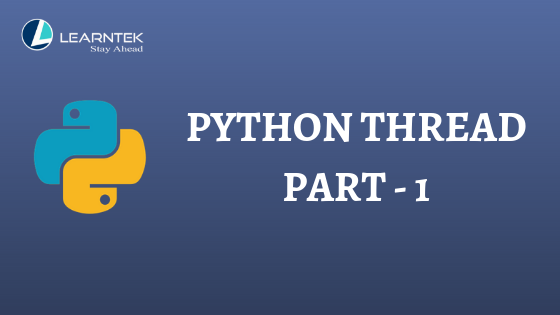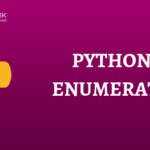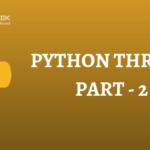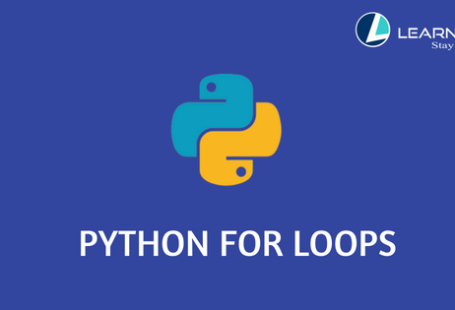Python Thread
A Python thread is like a process, and may even be a process, depending on the Python thread system. In fact, Python threads are sometimes called “lightweight” processes, because threads occupy much less memory, and take less time to create than do processes.
Threads allow applications to perform multiple tasks at once. Multi-threading is important in many applications.
In python, threading module is used to create the threads. In order to create threads, threading modules can be used in two ways. First, by inheriting the class and second by the use of thread function.
Python Thread creation using class :
Let us understand by using code.
import threading
class mythread(threading.Thread):
def __init__(self,i):
threading.Thread.__init__(self)
self.h =i
def run(self):
print "Value send ", self.h
thread1 = mythread(1)
thread1.start()
- New class mythread inherits the Python threading.Thread class
- __init__(self [,args]) Override the constructor
- run(): This is the section where you can put your logic part
- start(): The start() method starts a Python thread
- The mythread class overrides the constructor, so base class constructor (Thread.__init__()) must be invoked.
Python Thread creation using function :
import threading
def fun1(a,b):
c = a+b
print (c)
thread1 = threading.Thread(target=fun1, args=(12,10))
thread1.start()
The above code is very simple, just create a function and get it run by a thread. The syntax
threading.Thread(target=fun1, args=(12,10)) creates a thread, the target = fun1
specifies the function to be run and args indicates the tuple which contains the argument to be passed to the function.
Important threading methods
Let us see some important methods, defined in the threading modules.
threading.activeCount(): Returns the number of total Python thread that are active.
threading.activeCount(): Returns the number of total Python thread that are active.
Let us understand by the example.
import threading
import time
def fun1(a,b):
time.sleep(1)
c = a+b
print (c)
thread1 = threading.Thread(target=fun1, args=(12,10))
thread1.start()
thread2 = threading.Thread(target=fun1, args=(10,17))
thread2.start()
print ("Total number of threads", threading.activeCount())
print ("List of threads : ", threading.enumerate())
Let us see the output.

Figure 1 : All threads and thread list
Now comment the line time.sleep(1) and then run the code again.

Figure 2: Without sleep time
You can see the difference. The statement threading.activeCount() and threading.enumerate() have been run the main thread or main process. So, the main thread is responsible to run the entire program. In figure 1 when main thread executed the threading.activeCount(), that time thread1 and thread2 were active.
When we commented the time.sleep(1) syntax, and executed the code again then thread1 and thread3 might not be active.
The join method
Before discussing the significance of join method, let us see the following program.
import threading
import time
list1 = []
def fun1(a):
time.sleep(1) # complex calculation takes 1 seconds
list1.append(a)
thread1 = threading.Thread(target=fun1, args=(1,))
thread1.start()
thread2 = threading.Thread(target=fun1, args=(6,))
thread2.start()
print ("List1 is : ", list1)
In the above program, the two threads have been created with arguments. In target function fun1, a global list list1 is appended with an argument. Let us see the result.

Figure 3: Showing Empty list
The above figure is showing the empty list, but the list is expected to be filled with values 1 and 6. The statement print (“List1 is : “, list1) is executed by the main thread and main thread printed the list before getting it filled.
So main thread must be paused until all threads complete their jobs. To achieve the same, we shall use the join method.
Let see the modified code.
import threading
import time
list1 = []
def fun1(a):
time.sleep(1) # complex calculation takes 1 seconds
list1.append(a)
thread1 = threading.Thread(target=fun1, args=(1,))
thread1.start()
thread2 = threading.Thread(target=fun1, args=(6,))
thread2.start()
thread1.join()
thread2.join()
print ("List1 is : ", list1)
Let us see the output.

Figure 4: use of join method
In the above code the syntax thread1.join() block the main thread until thread1 finishes its task. In order to achieve parallelism, join method must be called after creation of all threads.
Let us see more use case of join methods.
import threading
import time
import datetime
t1 = datetime.datetime.now()
list1 = []
def fun1(a):
time.sleep(1) # complex calculation takes 1 seconds
list1.append(a)
list_thread = []
for each in range(10):
thread1 = threading.Thread(target=fun1, args=(each,))
list_thread.append(thread1)
thread1.start()
for th in list_thread:
th.join()
print ("List1 is : ", list1)
t2 = datetime.datetime.now()
print ("Time taken", t2-t1)
In the above code, we have used for loop to create 10 threads. Each thread is getting appended in the list list_thread. After creation of all threads, we used the join method. Let us see the output.

Figure 5: Out of join with loop
Time taken to execute is approx. 1 second. Since every thread take 1 second and we used thread-based parallelism that’s why total time is near to 1 second. If you use the join method after the creation of each thread program would take more than 10 seconds.
For more clarification see the following code.
import threading
import time
import datetime
t1 = datetime.datetime.now()
list1 = []
def fun1(a):
time.sleep(1) # complex calculation takes 1 seconds
list1.append(a)
for each in range(10):
thread1 = threading.Thread(target=fun1, args=(each,))
thread1.start()
thread1.join()
print ("List1 is : ", list1)
t2 = datetime.datetime.now()
print ("Time taken", t2-t1)
Output:

Figure 6: Thread with join method
From the above output, it is clear that, time taken is 10 seconds, it means no parallelism has been achieved because Join() method of first thread has been called before the creation of the second thread.
Method join with time
Let us see the following piece of code.
import threading import time def fun1(a): time.sleep(3) # complex calculation takes 3 seconds thread1 = threading.Thread(target=fun1, args=(1,)) thread1.start() thread1.join() print (thread1.isAlive())
The couples of things are new here. The isAlive() method returns the True or False. If the thread is currently active then the method isAlive() returns True otherwise False.
Output:

The above output shows thread is not active.
Let make a small change, make thread1.join() to thread1.join(2). It means, block the main thread only for 2 seconds.
Let us see the output:

In the above output, show thread was still active because join(2) kept blocking the main thread for 2 seconds but the thread took 3 seconds to complete its task.
threading.Timer()
This method is used set the time. Let us understand the syntax.
threading.Timer(interval, function, args=[], kwargs={})
The above syntax meaning is, after specified interval in seconds interpreter will execute the function with args and kwargs.






